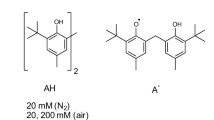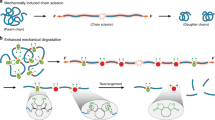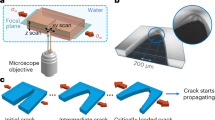Abstract
CRACK propagation in polymers is a topic of considerable importance to the technological application of these materials. In high-molecular-weight glassy polymers, crack propagation is normally assumed to require the breaking of covalent bonds in polymer chains that span the crack path, as opposed to chain slip and disentanglement. The fraction of such broken chains in a bulk sample would be very small, however, so that there is little direct evidence for this chain breakage1. Interfaces between immiscible polymers are often very weak, but can be strengthened by the presence of a diblock copolymer (a polymer in which each molecule consists of a block of one polymer bonded to a block of a different polymer) for which each of the two blocks is miscible with one of the homopolymers2. The diblock copolymer is thought to organize at the interface and so 'stitch' the homopolymers together. Here we show that crack propagation along the interface between the homopolymers involves breaking all the copolymer chains at a point in the region of the junction between the two blocks. Thus we demonstrate both that the block copolymer does indeed organize at the interface and that fracture involves the breaking of polymer chains. This information may suggest means by which the mechanical properties of polymer blends could be systematically improved.
This is a preview of subscription content, access via your institution
Access options
Subscribe to this journal
Receive 51 print issues and online access
$199.00 per year
only $3.90 per issue
Buy this article
- Purchase on Springer Link
- Instant access to full article PDF
Prices may be subject to local taxes which are calculated during checkout
Similar content being viewed by others
References
Kausch, H. H. Polymer Fracture 2nd edn (Springer, Berlin, 1987).
Brown, H. R. Macromolecules 22, 2859–2860 (1989).
Benninghoven, A., Rüdenauer, A. G. & Werner, H. W. Secondary Ion Mass Spectrometry (Wiley, New York, 1987).
Mills, P. J., Green, P. F., Palmstrom, C. J., Mayer, J. W. & Kramer, E. J. Appl. Phys. Lett. 45, 957–959 (1984).
Green, P. F. & Doyle, B. L. Characterization Techniques for Thin Polymer Films (ed. Ho Ming Tong) (Wiley, New York, 1989).
Kramer, E. J. Adv. Polym. Sci. 52/3, 1–56 (1983).
Mcleish, T. C. B., Plummer, C. J. G. & Donald, A. M. Polymer (in the press).
Evans, K. E. J. Polym. Sci., Polym. Phys. Edn 25, 353–368 (1987).
Ferry, J. D. Viscoelastic Properties of Solid Polymers 3rd edn (Wiley, New York, 1980).
Prest, W. M. Jr & Porter, R. S. J. Polym. Sci., Polym. Phys. Edn 10, 1639–1655 (1972).
Author information
Authors and Affiliations
Rights and permissions
About this article
Cite this article
Brown, H., Deline, V. & Green, P. Evidence for cleavage of polymer chains by crack propagation. Nature 341, 221–222 (1989). https://doi.org/10.1038/341221a0
Received:
Accepted:
Issue Date:
DOI: https://doi.org/10.1038/341221a0
This article is cited by
-
Measurement of the fracture toughness of polymer-non-polymer interfaces
Journal of Materials Science (1993)
Comments
By submitting a comment you agree to abide by our Terms and Community Guidelines. If you find something abusive or that does not comply with our terms or guidelines please flag it as inappropriate.



